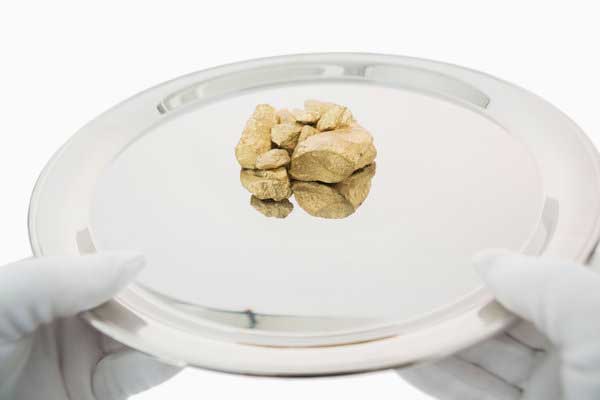The Federal Reserve claims they are fighting inflation, yet gold prices have fallen the least compared to other assets like stocks. This seeming contradiction points to a deeper understanding of what the Fed is actually doing and how it will impact commodity and precious metals markets going forward.

The Fed is Bursting the Stock Market Bubble, Not General Inflation
According to the transcript, the Fed’s policies over the past decade have inflated stock prices, creating a bubble. Their recent actions of raising rates and tightening monetary policy are designed to burst this bubble they created, not fight general inflation across the economy.
The inflation from the Fed’s easy money policies did not flow into commodities and real economic activity. It went straight into pumping up stock valuations and financial asset prices. This can be seen clearly in the Bloomberg Commodity Index, which collapsed from over 200 in 2008 down to the 50s by 2016, and stayed depressed for years.
Commodities Languished as Money Flowed to Stocks
Commodity prices remained low while the Fed pumped liquidity into financial markets. As the transcript states, prices for commodities like energy, grains, and metals reached “theoretically zero levels” even as stock markets surged ever higher.
The Fed is not concerned by inflated stock prices, but rising commodity inflation bothers them. So when commodity prices finally began rising rapidly in late 2020, the Fed pivoted to tightening policy and bursting the bubble they had created in stocks and financial assets over the past decade.
Attempts to Re-Inflate Burst Bubbles Typically Fail
According to the source, once a speculative bubble has decisively burst, it is very difficult if not impossible for central banks to re-inflate it.
2000s Financial Crisis Saw Failed Re-Inflation Attempts
He points out that the Fed aggressively cut rates and purchased assets after the dot-com bubble burst and during the 2008 financial crisis, but it did not stop the bleeding in those markets. Bruising collapses continued despite the Fed’s efforts at re-inflation.
Even more aggressive monetary interventions tend to make the situation worse once a bubble pops. Investors realize the high risks and low rewards of playing in popped markets, so they move capital elsewhere. This transfer of funds out of bursting bubbles cannot simply be reversed by policy easing.
Capital Flowing to Gold and Commodities as Stocks Slump
With stock markets decisively trending down and volatility spiking, fund managers are increasingly looking to move assets to safer havens like gold and commodities. Gold has held up much better than risk assets, indicating that institutional money is slowly rotating into alternative stores of value.
Gold Seen as Safe Haven as Crisis Looms
Some prominent investors like Ray Dalio of Bridgewater have commented publicly on the issues of fiat currency debasement and the need to find alternative holdings. The source believes this shows that major shifts are happening beneath the surface, with big pools of capital flowing out of stocks and into gold in particular.
This is due to a growing consensus that a government debt and wider monetary crisis is approaching. Gold stands ready to benefit immensely as a historically reliable safe haven and hedge against currency debasement.
Current Pullbacks Setting Stage for Next Commodity Run
The transcript argues that the pullback in commodity prices over the past several months is corrective within an ongoing bull market, not the end of the uptrend. It represents a pause and consolidation phase rather than a trend reversal.
Food Commodities May Lead Next Leg Higher
Once this commodity correction concludes, potentially explosive upside moves are expected in both energy and agriculture markets. Food commodities in particular could make dramatic headlines in the next leg higher, exacerbating inflationary pressures.
These coming commodity spikes will likely force central banks back into extreme accommodation and expansionary policy to bail out struggling governments. This would act as rocket fuel for monetary metals like gold and silver.
Gold Still Early in its Current Bull Market
Looking at historical bull markets, gold has seen seven to eight-fold price increases over the preceding bear market low. The current bull remains early, with prices only about double the 2015 bottom. Another repeat of past performance would take gold up to $8,000 per ounce.
Normal Silver Ratio Points to Triple Digit Prices
Silver has spent the majority of the past 50 years trading at a ratio of at least 2% the price of gold. If gold hits $8,000 per ounce, a 2% ratio would put silver over $150. Given silver’s more speculative nature, surpassing this historical norm is easily imaginable during a crisis scenario.
The groundwork has already been laid for the kind of monetary breakdown and loss of faith in fiat currencies that propels gold and silver to astronomical heights. While astounding price predictions seem far fetched now, history shows they are well within the realm of possibility.
In summary, the Federal Reserve is working to deflate the epic stock market bubble they created, not combat general commodity-driven inflation. Their tightening policies are likely to induce a government debt and monetary crisis, during which gold and silver will return to their traditional roles as safe haven assets. While volatile corrections are still ahead, the long-term bull case for precious metals remains extremely compelling.
